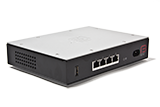FireBrick IPv6 Tunnel
To add a tunneled IPv6 block to your FireBrick (2500/2700) and advertise it on your LAN subnet do the following:
Create a route
<route ip="::/0" gateway="81.187.81.6" comment="IPv6 default route using IPv4 tunnel"/>
Here 81.187.81.6 is the AAISP tunnel endpoint, and we've created an IPv6 default route to it - if you are using someone else for the tunnel, then use their endpoint.
Update your LAN subnet to include
- ra="true"
- ra-mtu="1480" (1472 if MTU was 1492 before, e.g. over PPPoE)
- ra-dns="2001:8b0::2020 2001:8b0::2021"
- and add an IPv6 address from your block to the ip= element.
The smaller MTU is required due to the IPv6 packets being placed inside IPv4 packets.
Once saved, machines on your LAN should be given IPv6 addresses, and they will use the FireBrick as their IPv6 gateway, which in turn will use the tunnel endpoint.
Add a firewall rule to allow the tunnel in
You may need to allow the tunnel into your FireBrick with a rule such as:
<rule name="IPv6 tunnel" source-interface="WAN" target-interface="SELF" source-ip="81.187.81.6" protocol="41"/>
Hurricane Electric tunnelbroker.net tunnel
It's also really easy to set up an IPv6 tunnel from http://tunnelbroker.net if you are using a FB2700 on an ISP which doesn't already support IPv6. If the details for your tunnel on your control panel say your server IPv4 address is 192.0.2.26 and your client IPv6 is 2001:DB8:ABCD:123E::2 then you would put the following in your config:
<route comment="Tunnel server IPv4 address" ip="::/0" gateway="192.0.2.26"/>
<loopback comment="Tunnel client IPv6 address" ip="2001:DB8:ABCD:123E::2"/>
Then create a LAN subnet entry with your routed /64 (or /48) and firewall rule as above.
